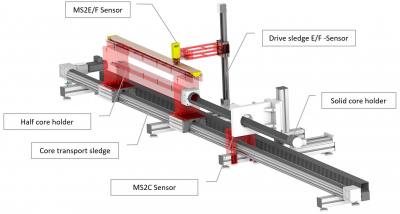Universal Logging System
The Universal Logging System (ULS) is a device for automated and quality-assured logging of physical properties of core samples.

Different sensor types allow the measurement of drilling and sediment cores with a diameter of 30 to 150 mm cut into sections up to 1,350 mm long. A servo motor system ensures almost backlash-free and slip-free transport of sediment cores weighing up to 30 kg and with a speed of up to 10 cm/s safely and precisely. This makes the system significantly faster than all other systems of this type on the market.
Functionality and concept of use:
The ULS has been optimized for use in the laboratory, but can also be quickly disassembled, making it suitable for mobile use. LabVIEW control software optimized for the measurement sequences guarantees fast and reliable measurement progress (pre-input of core metadata, simple core handling by forward and reverse, displays for measurement and data status, flexible measurement sequence based on single segments). Data processing generates export formats in ASCII format.
Scientific Benefit:
The ULS has been used in the laboratory since 2006 for high-resolution and non-destructive measurement of sedimentary physical properties on closed or open cores. The magnetic susceptibility sensors provide meaningful and complementary lithologs for core language and stratigraphy. These logging data are of great use to many scientists and users because they allow rapid assessment of the age and quality of the cores obtained. Core logs and scans are fully reproduced and described. They are an authoritative selection criterion for subsequent detailed core studies. Susceptibility logs reproduce climate-induced lithology changes particularly concisely and are therefore used for core retrieval and for cyclostratigraphic correlation of cores. Applications include geological and pedological surveys, paleomagnetics, archaeological prospecting, paleoclimate studies, hydrology, sedimentology, core logging/correlation, and magnetic analysis. In archaeology, this system can be used to measure the enhancement of magnetic susceptibility in soils resulting from human occupation, mainly by burning. The measurements are non-destructive, and the low frequency ensures that the results are unaffected by the conductivity of the sample.
Design and equipment:
MS2C Loop sensor:
A range of ring sensors with diameters from 36 to 162 mm are available for high-resolution volume susceptibility measurements on whole cores. They are suitable for measuring any type of peat, lake or marine sediment cores, provided they are not metal clad. These robust sensors have a very low temperature drift.
- Specification:
- Manufacturer: Bartington Instruments Ltd.
- Inner diameter of sensors: 36 - 162 mm
- Working frequency: 0.565 kHz
- Drift at room temperature: <2 x 10-5 SI (vol) in 10 Minuten
MS2E Contact sensor:
This sensor is suitable for high resolution measurements on the surface of split drill or soft sediment cores. The sensitive area of the probe, has the shape of a rectangle of 3.8 mm x 10.5 mm, which allows very fine resolution surface measurements.
- Specification:
- Manufacturer: Bartington Instruments Ltd.
- Working range: 3,8mm x 10,5mm
- Working depth: 50 % bis 1mm, 10 % bis 3,5mm
- Working frequency: 2 kHz
- Drift at room temperature: <5 x 10-6 CGS in 5 Minuten
MS2F Contact sensor:
This miniature sensor is ideal for the stratigraphic investigation of exposed geological areas. It is also used when difficult surface conditions exist that cannot be measured with the MS2E sensor.
- Specification:
- Manufacturer: Bartington Instruments Ltd.
- Typ: Cylindrical coil with 10 mm diameter
- Working depth: Von der Spulenoberfläche bis zu einer Tiefe von 4,5 mm, 10% ab 6 mm
- Working frequency: 0,58 kHz
- Drift at room temperature: <10 x 10-6 CGS in 20 Minuten
MS2 Control unit:
The MS2 meter can be connected to a wide range of individually calibrated sensors. When sample material enters the sphere of influence of the low-frequency, 100μT strong alternating magnetic field generated by the sensor, a frequency change results. This is converted to a value of magnetic susceptibility, which is provided digitally in SI or CGS units, depending on the choice. Diamagnetic (negative) values can also be measured.
- Magnetic Susceptibility Meter:
- Manufacturer: Bartington Instruments Ltd.
- Measuring range:
- 1 - 9999 x 10-5 SI (x10-6 CGS) volumenspezifisch
- 1 - 9999 x 10-8 SI (x10-6 CGS) massenspezifisch
- Resolution: 2 x 10-6 SI (2 x 10-7 CGS) bei x 0.1 Bereich
- Measuring time: 1 s oder 10s
Basic dimensions:
- The base area of the system is 3 meters in length, 0.5 meters in width
Measurement speed:
- The measurement speed at a typical measurement trigger of 1 cm is 14 minutes per core meter
Software:
- Fully automatic acquisition and control of all sensors and drives
- Monitoring of the measurement process
- Output of all acquired measurement and processed measurement values and raw data
- Logging of all measurement steps and storage
- Configurable thanks to editable initialization file in plain text
- Expandable, thanks to open source LabVIEW software
Extensibility:
- Any actuators and sensors with the following interfaces:
- RS 232/485
- Ethernet
- PCI - interfaces


